操作手册-demo-2010
MDT2010部署完全实验手册

• 和SCCM 2007的任务序列结构功能一致,可以采用导入的方式,在SCCM 2007使用MDT 2010的任务序列。
MDT数据库
使 用 MDT 数 据 库,可 以有 针 对 性 的 设 置 计 算机 和计算机集合的自定义安装参数,实 现近乎于ZTI的动态安装。
• WinPE 3.0 • DISM • System Image Manager • Sysprep • VAMT • USMT
Windows PE 3.0
Windows预安装环境(Windows PE) 3.0是具有有限服务、构建于Windows 7内核上的最小Win32操作系统。它用 于为Windows安装准备计算机、从网络文件服务器复制磁盘映像以及初始化Windows安装程序。
部署映像服务和管理(DISM)概述
• 替代pkgmgr、PEImg和IntlConfg工具 • 支持离线和在线映像服务 • 支持WIM和VHD格式 • 改进了诊断、错误报告和通信 • 提供跨结构、跨版本和跨技术的支持服务
DISM命令行示例
Windows SIM
Windows系统映像管理器(Windows SIM)可在图形用户界面(GUI)中创建和管理无人参与的Windows安装程序应答文 件。 Use Windows SIM to: • 根据Windows映像(.wim)文件验证现有应答文件的设置。 • 查看.wim文件中所有可配置的组件设置。 • 轻松更新现有应答文件。 • 创建包含完整的可移动文件夹集(带有安装文件)的配置集。 • 将第三方驱动程序、应用程序或其他程序包添加到应答文件
demo-操作使用手册
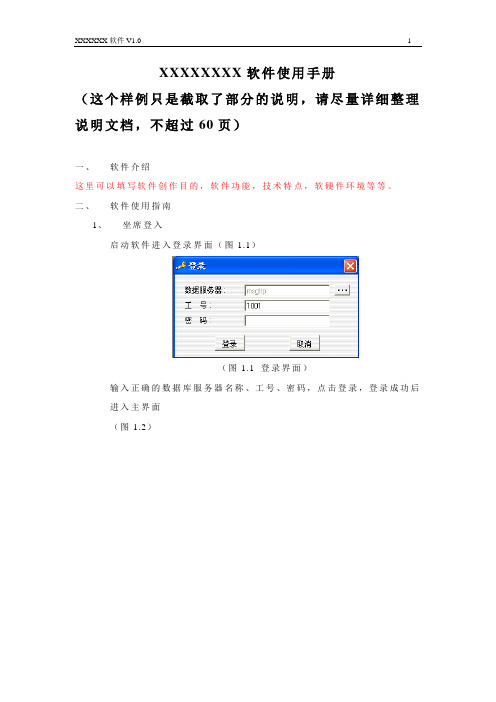
XXXXXXXX软件使用手册(这个样例只是截取了部分的说明,请尽量详细整理说明文档,不超过60页)一、软件介绍这里可以填写软件创作目的,软件功能,技术特点,软硬件环境等等。
二、软件使用指南1、坐席登入启动软件进入登录界面(图1.1)(图1.1 登录界面)输入正确的数据库服务器名称、工号、密码,点击登录,登录成功后进入主界面(图1.2)(图1.2 主界面)2、任务选择(1.3 任务列表)在主界面的任务列表区域,如图(1.3)。
列表中包含当前坐席被分配到的所有任务。
坐席点击选择将执行的任务,该任务的基本信息显示在(图1.4)当前任务信息区域(图1.4 当前任务信息)任务脚本是与客户交流的内容、注意点等相关信息分配方式包含两种,配额方式和抢占方式获取数据(图1.5 客户数据)i.获取客户资料如果当前任务的数据分配方式为“抢占方式”。
点击“获取”按钮,获取到客户的资料显示在客户明细(图1.6)和客户数据列表(图1.5)如果当前任务的数据分配方式为“配额方式”。
预先分配给坐席的客户信息将全部显示在客户数据列表(图1.5)中,坐席点击选择一个客户,客户详细信息显示在客户明细(图1.6)中ii.未完成信息“已完成”选择项(图1.5中),该选项未选中时,列表中显示状态为“待处理”的客户iii.已完成信息“已完成”选择项(图1.5中),该选项未选中时,列表中显示其他状态的客户iv.刷新客户数据列表点击“刷新”按钮,刷新客户数据列表,显示最新的客户状态和处理情况3、企业资料编辑(图1.6 客户明细)i.企业资料编辑客户明细区域显示企业的详细资料,可编辑,点击“修改”按钮保存ii.联络人点击“联络人”按钮,进入企业联络人列表界面(图1.7)iii.客户交流日志列表客户交流日志列表显示当前客户曾经参与的所有任务的历史交流日志和当前任务的交流日志。
历史交流日志可浏览,但不可以修改。
iv.新增日志点击“新增日志”,进入新增该客户在当前任务的交流日志界面。
畅想软件2010版(新版本)使用说明书

Intersky Smarterp(标准版)V2010使用说明书目录第一章安装说明 (4)1.1 安装须知 (4)1.2 安装平台 (4)1.2安装工程 (12)1.3 添加登录模式 (14)第二章系统控制台 (15)第三章查询界面 (16)3.1 界面布局 (16)3.1.1 视图、过滤、查找 (18)3.2 查询 (20)3.2.1 关键字查询 (21)3.3【文件】菜单项介绍 (22)3.3.1 新建记录功能 (22)3.3.2 打开记录功能 (22)3.3.3 复制整条记录功能 (22)3.3.4 导入导出 (22)3.3.5报表 (22)3 . 3. 6 删除 (22)3. 3. 7 附件 (22)3 .3 .8提醒 (22)3.3.9移动到目录 (22)3.3.10属性 (22)3.3.11 关闭功能 (22)3.4工具栏介绍 (22)3.4.1文件夹 (22)3.4.2标记 (22)3.4.3查询 (22)3.4.4 视图 (22)3. 4. 5 数据链接 (22)3.5 自定义表格的控制 (22)3.5.1工作流 (22)第四章编辑界面 (22)4.1 编辑界面基础知识——编辑类型 (22)4.1.1 TextEdit 文本编辑框 (22)4.1.2 ComboBox下拉编辑框 (22)4.1.3 DateEdit日期编辑框 (22)4.1.4电子邮件编辑框 (22)4.1.5网页编辑框 (22)4.1.6唛头编辑框 (22)4.2 子表信息录入 (22)4.2.1 导入 (22)4.2.3 条码输入 (22)4.2.3 专家输入 (22)4.2.4 从Excel 粘贴 (22)第五章决策分析 (22)第六章系统管理 (22)6.1 用户管理 (22)6.1.1 新建组织架构 (22)6.1.2 新建角色 (22)6.1.3 新建用户 (22)6.1.4添加邮箱 (22)6.2 切换操作员、修改密码、日志管理 (22)6.3数据字典 (22)6.4 Smart Search (22)6. 5 工作流管理 (22)6. 6 邮件管理 (22)6. 7 系统选项 (22)6. 8 传真管理 (22)6.8. 1 新建传真 (22)6. 8. 2保存、发送传真 (22)6. 8. 3回复、转发、再次发送 (22)6. 9 短信管理 (22)6.9.1 新建 (22)第一章安装说明1.1 安装须知1)运行环境硬件环境:服务器(内存:2G或更高、CPU: 3.0G 以上,VGA);工作站(内存:512M 或更高、CPU: 1.0G 以上,VGA);局域网(WINDOWS NT 局域网络,分布在一栋大楼中)软件环境:SERVER端:Windows 2000 Advance Server (SP4) 或Windows 2003 Server(SP2,已激活),推荐服务器操作系统的补丁打到最新,数据库:MS SQLServer 2000 SP4 或2005 SP2或2008; 装OFFICE办公软件,推荐使用OFFICE2003 SP2或office2007CLIENT端:WIN 2000、WIN XP(推荐),装OFFICE 办公软件,推荐使用OFFICE2003 SP2或office20072)版权信息本说明书的信息如有变动,将会另行通知。
中文版Project2010实用教程第二章Project2010快速入门
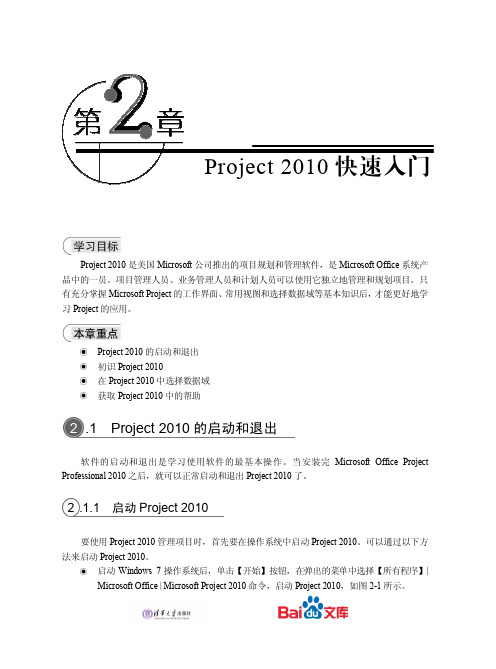
2 .1 Project 2010 的启动和退出
软件的启动和退出是学习使用软件的最基本操作。当安装完 Microsoft Office Project Professional 2010 之后,就可以正常启动和退出 Project 2010 了。
中文版 Project 2010 实用教程
单击【开始】按钮,从弹出的【开始】菜单中的高频栏中选择 Microsoft Project 2010 命令,即可启动 Project 2010。 双击桌面上创建 Project 2010 快捷图标来启动 Project 2010,如图 2-2 所示。 在桌面或者文件夹内的空白区域右击,从弹出的快捷菜单中选择【新建】|【Microsoft Project 文档】命令,创建一个名为“新建 Microsoft Project 文档”的文件。双击该文 件图标,即可启动 Project 2010,并打开创建的新文档。
2 .1.1 启动 Project 2010
要使用 Project 2010 管理项目时,首先要在操作系统中启动 Project 2010。可以通过以下方 法来启动 Project 2010。
启动 Windows 7 操作系统后,单击【开始】按钮,在弹出的菜单中选择【所有程序】| Microsoft Office | Microsoft Project 2010 命令,启动 Project 2010,如图 2-1 所示。
-16-
区及状态栏等组成。
快速访问 工具栏Leabharlann 全选按钮 行标题 数据表区
域标题
Project2010简易操作指南
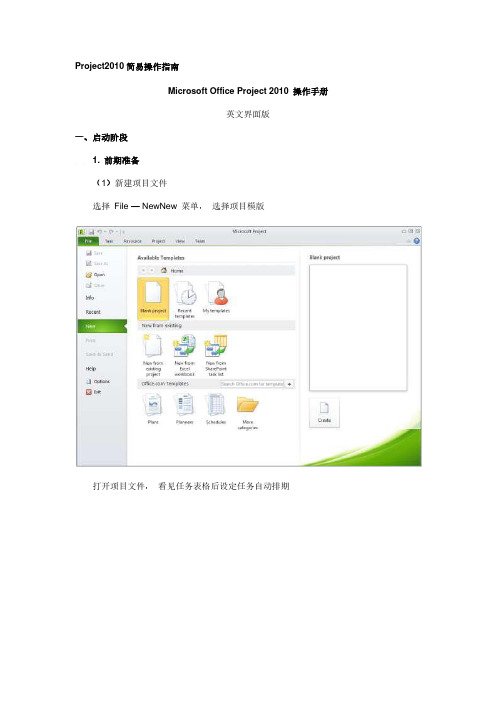
Project2010简易操作指南Microsoft Office Project 2010 操作手册英文界面版一、启动阶段1. 前期准备(1)新建项目文件选择File — NewNew 菜单,选择项目模版打开项目文件,看见任务表格后设定任务自动排期(2)设置项目信息自定义日历选择“ Project”下的“Change Working Time”菜单点击“Create New Calendar”,输入日历名称设置工作时间,选择工作周中的默认行,点击“Detail”按钮,选择周一至周五,设定实际的工作时间,设置非工作时间(图中设置10月1日-7日为非工作日)Project 2010简介在Project 2010 客户端版本中,我们致力于使其更易于进行入门学习、更易于规划和更易于报告。
本文简要介绍Project 2010 的几个亮点,您可以在Project 团队的官方博客中找到更详细的文章。
更易于进行入门学习您将最先注意到的变化之一是Office Fluent 用户界面取代了菜单和工具栏,从而更便于查找常用命令。
下面是Project 功能区中的“任务”(Task) 选项卡:此外,我们还对复制/粘贴功能做了改进,现在,当您向Project 中粘贴项目符号列表时,将保留原有的层次结构和格式。
请注意下面的任务11 - 没错,现在我们支持自动换行。
更易于规划不,您的眼睛并没有骗您,上图中的任务确实没有持续时间或日期。
原因是我们添加了一项名为“用户控制计划”(User-controlled Scheduling) 的新功能,该功能将控制过程和易用性集成在一起,使您可以完全控制您的计划。
如果您不了解某一任务的所有信息,Project 不会强迫您输入相关值。
如果您不希望运行任务,Project 将不会运行该任务,但会在可能出现计划问题时发出警告。
在Project 2010 中,既可以自动安排任务,也可以手动安排任务(使用新增的用户控制计划功能)。
微软Word 2010用户教程说明书
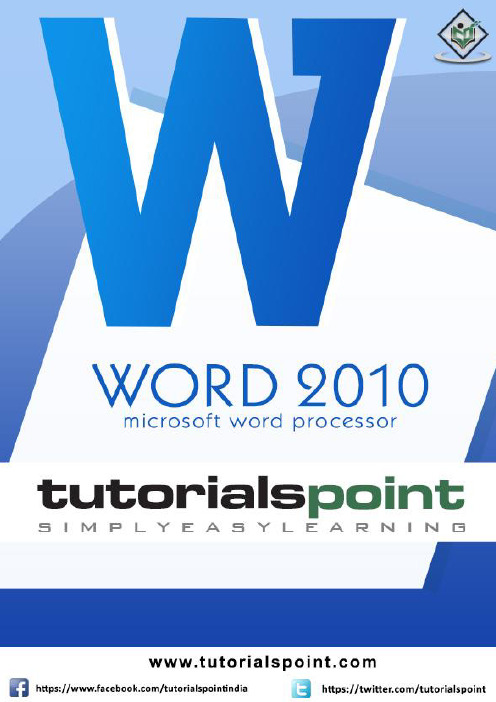
About the T utorialMicrosoft Office Word 2010 allows you to create and edit personal and business documents, such as letters, reports, invoices, emails and books.By default, documents saved in Word 2010 are saved with the .docx extension. Microsoft Word can be used for the following purposes:∙To create business documents having various graphics including pictures, charts, and diagrams.∙To store and reuse readymade content and formatted elements such as cover pages and sidebars.∙To create letters and letterheads for personal and business purpose.∙To design different documents such as resumes or invitation cards etc.∙To create a range of correspondence from a simple office memo to legal copies and reference documents.AudienceThis tutorial has been designed for computer users who are willing to learn Microsoft Word in simple steps and they do not have much knowledge about computer usage and Microsoft applications. This tutorial will give you enough understanding on MS Word from where you can take yourself to higher levels of expertise.PrerequisitesBefore you begin with this tutorial, we assume you have a basic understanding of Computer peripherals like mouse, keyboard, monitor, screen, etc. and their basic operations.Copyright & Disclaimer© Copyright 2018 by Tutorials Point (I) Pvt. Ltd.All the content and graphics published in this e-book are the property of Tutorials Point (I) Pvt. Ltd. The user of this e-book is prohibited to reuse, retain, copy, distribute or republish any contents or a part of contents of this e-book in any manner without written consent of the publisher.We strive to update the contents of our website and tutorials as timely and as precisely as possible, however, the contents may contain inaccuracies or errors. Tutorials Point (I) Pvt. Ltd. provides no guarantee regarding the accuracy, timeliness or completeness of our website or its contents including this tutorial. If you discover any errors on our website or inthistutorial,******************************************T able of ContentsAbout the Tutorial (i)Audience (i)Prerequisites (i)Copyright & Disclaimer (i)Table of Contents (ii)MS WORD BASICS 0Word 2010 ─ Getting Started (1)Word 2010 ─ Ex plore Window (5)Word 2010 ─ Backstage View (8)Document Information (10)Document Properties (10)Exit Backstage View (10)Word 2010 ─ Entering Text (11)Word 2010 ─ Move .Around (13)Moving with Mouse (13)Moving with Scroll Bars (14)Moving with Keyboard (15)Moving with Go To Command (16)Word 2010 ─ Save Document (17)Saving New Document (17)Saving New Changes (18)Word 2010 ─ Opening a Do cument (20)Opening New Document (20)Opening Existing Document (22)Word 2010 ─ Closing a Document (25)Word 2010 ─ Context Help (28)Context Sensitive Help (28)Using F1 Key (28)Using Help Icon (30)Using Help Option (31)EDITING DOCUMENTS (32)Word 2010 ─ Insert Text (33)Insert and Add Text (33)Insert and Replace Text (35)Word 2010 ─ Select Text (40)Using the Selection Bar (41)Using the Keyboard (42)Word 2010 ─ Delete Text (43)Using Backspace & Delete Keys (43)Using Selection Method (44)Word 2010 ─ Move Text (46)Move within the same document (46)Move within different documents (47)Word 2010 ─ Copy & Paste (51)Copy & Paste Operation (51)Cut & Paste Operation (54)Copy, Cut & Paste in different documents (56)Word 2010 ─ Find & Replace (57)Find Command (57)Find & Replace Operation (61)Word 2010 ─ Spell Check (63)Check Spelling and Grammar using Review tab (64)Check Spelling and Grammar using Right Click (67)Word 2010 ─ Zoom In-Out (68)Zoom-in & Zoom-out using view tab (68)Zoom-in & Zoom-out using (+) and (-) Buttons (70)Word 2010 ─ Special Symbols (71)Insert Special Symbols (71)Assign Shortcut Key (74)Word 2010 ─ Undo Changes (76)How to use Undo & Repeat operations (76)Shortcuts to use Undo & Repeat operations (79)FORMATTING TEXT (80)Word 2010 ─ Setting Text Fonts (81)Change the Font Type & Size (81)Use Shrink and Grow Buttons (85)Clear Formatting Options (86)Word 2010 ─ Text Decoration (87)Making text bold (87)Making Text Italic (87)Underline the Text (89)Strikethrough the Text (90)Word 2010 ─ Change Text Case (91)Change Text to Sentence Case (91)Change Text to Lowercase (92)Change Text to Uppercase (93)Capitalize Text (94)Toggle the Text (95)Word 2010 ─ Change Text Color (96)Change Font Colors (96)Highlight Text with Colors (97)Apply Text Effects (97)Word 2010 ─ Text Alignments (99)Left-Aligned Text (99)Center Aligned Text (100)Right-Aligned Text (101)Justified Text (102)Word 2010 ─ Indent Paragraphs (103)Left Indentation (103)Right Indentation (104)First Line Indentation (104)Hanging Indentation (105)Word 2010 ─ Create Bullets (107)Create a List from Existing Text: (107)Create a List as You Type (108)Word 2010 ─ Set Line Spacing (111)Spacing between Lines (111)Spacing between Paragraphs (112)Word 2010 ─ Borders and Shades (113)Add Borders to Text (113)Add Borders to Page (115)Add Shades to Text (117)Word 2010 ─ Set Tabs (120)Setting a Tab (121)Moving a Tab (124)Word 2010 ─ Apply Formatting (126)Copy and Apply Text Formatting (126)Copy and Apply Text Formatting multiple times (127)FORMATTING PAGES (128)Word 2010 ─ Adjust Page Margins (129)Adjust Margins (129)Word 2010 ─ Header and Footer (132)Add Header and Footer (132)Edit Header and Footer (135)Word 2010 ─ Add Page Numbers (137)Add Page Numbers (137)Remove Page Numbers (140)Word 2010 ─ Insert Page Breaks (141)Insert Page Breaks (141)Delete a Page Break (142)Wo rd 2010 ─ Insert Blank Page (143)Insert Blank Pages (143)Delete Blank Pages (144)Word 2010 ─ Cover Pages (146)Add Cover Pages (146)Delete Cover Pages (148)Word 2010 ─ Page Orientation (149)WORKING WITH TABLES (152)Word 2010 ─ Create a Table (153)Create a Table (153)Delete a Table (157)Word 2010 ─ Rows & Columns (158)Add a Row (158)Delete a Row (160)Add a Column (162)Delete a Column (164)Word 2010 ─ Move a Table (166)Word 2010 ─ Resize a Table (168)Word 2010 ─ Merging Cells (170)Word 2010 ─ Split a Table (172)Word 2010 ─ Split Cells (174)Word 2010 ─ Add Formula (177)Word 2010 ─ Borders & Shades (181)Add Borders to Table (181)Using Border Options (182)Add Shades To Table (185)ADVANCED OPERATIONS (187)Word 2010 ─ Quick Styles (188)Apply Quick Styles (188)Change Styles (190)Word 2010 ─ Use Templates (193)Using Existing Template (193)Create New Template (196)Word 2010 ─ Use Graphics (198)Adding Picture in Document (198)Adding WordArt in Document (199)Word 2010 ─ Auto Correction (202)Word 2010 ─ Auto Formatting (205)Word 2010 ─ Table of Contents (209)Create Table of Contents (209)Update Table of Contents (212)Delete Table of Contents (214)Word 2010 ─ Preview Documents (215)Word 2010 ─ Printing D ocuments (217)Word 2010 ─ Email Documents (221)Word 2010 ─ Translate Document (223)Word 2010 ─ Compare Documents (227)Compare Two Documents (227)Word 2010 ─ Document Security (232)Set Document Password (232)Remove Document Password (234)Set Editing & Formatting Restrictions (237)Remove Editing & Formatting Restrictions (240)Word 2010 ─ Set Watermark (242)Set Standard Watermark (242)Set Custom Watermark (244)Remove Watermark (247)MS Word Basics1Word 2010 2In this chapter, we will discuss how to get started with Word 2010. We will understand how to start a Word 2010 application in simple steps. Assuming you have Microsoft Office 2010 installed in your PC, to start the Word application, follow these steps: Step 1: Click the Start button.Word 2010 ─ Getting StartedWord 20103Step 2: Click the All Programs option from the menu.4Step 3: Search for Microsoft Office from the submenu and click it.5Step 4: Search for Microsoft Word 2010 from the submenu and click it.This will launch the Microsoft Word 2010 application and you will see the following window.6Word 2010 7In this chapter, we will understand how to explore Window in Word 2010. Following is the basic window which you get when you start the Word application. Let us understand the various important parts of this window.File TabThe File tab replaces the Office button from Word 2007. You can click it to check the Backstage view . This is where you come when you need to open or save files, create new documents, print a document, and do other file-related operations.Word 2010 ─ Explore Window8Quick Access ToolbarThis you will find just above the File tab. This is a convenient resting place for the most-frequently used commands in Word. You can customize this toolbar based on your comfort. RibbonRibbon contains commands organized in three components:∙Tabs: These appear across the top of the Ribbon and contain groups of related commands. Home, Insert, Page Layout are examples of ribbon tabs.∙Groups: They organize related commands; each group name appears below the group on the Ribbon. For example, group of commands related to fonts or group of commands related to alignment, etc.∙Commands: Commands appear within each group as mentioned above.Title barThis lies in the middle and at the top of the window. Title bar shows the program and document titles.RulersWord has two rulers - a horizontal ruler and a vertical ruler. The horizontal ruler appears just beneath the Ribbon and is used to set margins and tab stops. The vertical ruler appears on the left edge of the Word window and is used to gauge the vertical position of elements on the page.HelpThe Help Icon can be used to get word related help anytime you like. This provides nice tutorial on various subjects related to word.Zoom ControlZoom control lets you zoom in for a closer look at your text. The zoom control consists of a slider that you can slide left or right to zoom in or out; you can click the + buttons to increase or decrease the zoom factor.View ButtonsThe group of five buttons located to the left of the Zoom control, near the bottom of the screen, lets you switch through the Word's various document views.9∙Print Layout view: This displays pages exactly as they will appear when printed.∙Full Screen Reading view: This gives a full screen view of the document.∙Web Layout view: This shows how a document appears when viewed by a Web browser, such as Internet Explorer.∙Outline view: This lets you work with outlines established using Word’s standard heading styles.∙Draft view: This formats text as it appears on the printed page with a few exceptions. For example, headers and footers aren't shown. Most people prefer this mode.Document AreaThis is the area where you type. The flashing vertical bar is called the insertion point and it represents the location where text will appear when you type.Status BarThis displays the document information as well as the insertion point location. From left to right, this bar contains the total number of pages and words in the document, language, etc.You can configure the status bar by right-clicking anywhere on it and by selecting or deselecting options from the provided list.Dialog Box LauncherThis appears as very small arrow in the lower-right corner of many groups on the Ribbon. Clicking this button opens a dialog box or task pane that provides more options about the group.Word 2010 10In this chapter, we will discuss the Backstage View in Word 2010. The Backstage view was introduced in Word 2010. This acts as the central place for managing your documents. The backstage view helps in creating new documents, saving and opening documents, printing and sharing documents, and so on.Getting to the Backstage View is easy: Just click the File tab , located in the upper-left corner of the Word Ribbon. If you already do not have any opened document, then you will see a window listing down all the recently opened documents as follows:If you already have an opened document, then it will display a window showing detail about the opened document as shown below. Backstage view shows three columns when you select most of the available options in the first column.Word 2010 ─ Backstage View11The first column of the backstage view will have following options:12Document InformationWhen you click the Info option available in the first column, it displays the following information in the second column of the backstage view:∙Compatibility Mode: If the document is not a native Word 2007/2010 document, a Convert button appears here, enabling you to easily update its format. Otherwise, this category does not appear.∙Permissions: You can use this option to protect your word document. You can seta password so that nobody can open your document, or you can lock the documentso that nobody can edit your document.∙Prepare for Sharing: This section highlights important information you should know about your document before you send it to others, such as a record of the edits you made as you developed the document.∙Versions: If the document has been saved several times, you may be able to access the previous versions of it from this section.Document PropertiesWhen you click the Info option available in the first column, it displays various properties in the third column of the backstage view. These properties include the document size, the number of pages in the document, the total number of words in the document, the name of the author etc.You can also edit various properties by clicking on the property value and if the property is editable, then it will display a text box where you can add your text like title, tags, comments, Author.13Exit Backstage ViewIt is simple to exit from the Backstage View. Either click on the File tab or press the Esc button on the keyboard to go back to the working mode of Word.Word 2010 14In this chapter, let us discuss how to enter text with Microsoft Word 2010. Let us see how easy it is to enter text in a Word document. We assume you know that when you start Word, it displays a new document by default as shown below:Document area is the area where you type your text. The flashing vertical bar is called the insertion point and it represents the location where the text will appear when you type. keep the cursor at the text insertion point and start typing the text. We typed only two words "Hello Word" as shown below. The text appears to the left of the insertion point as you type:Word 2010 ─ Entering TextWord 201015The following are the two important points that will help you while typing:∙You do not need to press Enter to start a new line. As the insertion point reaches the end of the line, Word automatically starts a new one. You will need to press Enter, to add a new paragraph.∙When you want to add more than one space between words, use the Tab key instead of the spacebar. This way you can properly align text by using the proportional fonts.Word 2010 16In this chapter, we will discuss how to move around in Word 2010. Word provides a number of ways to move around a document using the mouse and the keyboard.To begin with, let us create some sample text. To create a sample text, there is a short cut available. Open a new document and type =rand() and press Enter. Word will create the following content for you:Moving with MouseYou can easily move the insertion point by clicking in your text anywhere on the screen. There may be instances when a document is big and you cannot see a place where you want to move. Here, you will have to use the scroll bars, as shown in the following screenshot:Word 2010 ─ Move Around17You can scroll through your document by rolling your mouse wheel, which is equivalent to clicking the up-arrow or down-arrow buttons in the scroll bar.Moving with Scroll BarsAs shown in the above screenshot, there are two scroll bars: one for moving vertically within the document, and one for moving horizontally. Using the vertical scroll bar, you may:∙Move upward by one line by clicking the upward-pointing scroll arrow.∙Move downward by one line by clicking the downward-pointing scroll arrow.∙Move one next page, using the next page button (footnote).∙Move one previous page, using the previous page button (footnote).∙Use the Browse Object button to move through the document, going from one chosen object to the next.18Moving with KeyboardThe following keyboard commands, used for moving around your document, also move the insertion point:You can move word by word or paragraph by paragraph. You would have to hold down the Ctrl key while pressing an arrow key, which moves the insertion point as described here: Ctrl +Ctrl +Ctrl +19Ctrl +Moving with Go T o CommandPress the F5 key to use the Go To command. This will display a dialogue box where you will have various options to reach to a particular page.Normally, we use the page number, the line number or the section number to go directly to a particular page and finally press the Go To button.Word 2010 20In this chapter, we will discuss how to save a document in Word 2010.Saving New DocumentOnce you are done with typing in your new Word document, it is time to save your document to avoid losing work you have done on a Word document. Following are the steps to save an edited Word document:Step 1: Click the File tab and select the Save As option.Word 2010 ─ Save Document21Step 2: Select a folder where you will like to save the document, Enter the file name which you want to give to your document and Select the Save As option, by default it is the .docx format.Step 3: Finally, click on the Save button and your document will be saved with the entered name in the selected folder.Saving New ChangesThere may be an instance when you open an existing document and edit it partially or completely, or an instance where you may like to save the changes in between editing of the document. If you want to save this document with the same name, then you can useeither of the following simple options:22∙Just press the Ctrl + S keys to save the changes.∙Optionally you can click on the floppy icon available at the top left corner and just above the File tab. This option will also help you save the changes.∙You can also use the third method to save the changes, which is the Save option available just above the Save As option as shown in the above screenshot.If your document is new and it was never saved so far, then with either of the three options, Word will display a dialogue box to let you select a folder, and enter the document name as explained in case of saving new document.Word 2010 23In this chapter, we will discuss how to open a document in Word 2010.Opening New DocumentA new, blank document always opens when you start Microsoft Word. Suppose you want to start another new document while you are working on another document, or you closed an already opened document and want to start a new document. Here are the steps to open a new document:Step 1: Click the File tab and select the New option.Step 2: When you select the New option from the first column, it will display a list of templates in the second column. Double-click on the Blank document ; this is the firstWord 2010 ─ Opening a Document24option in the template list. We will discuss the other templates available in the list in the following chapters.You should have your blank document as shown below. The document is now ready for you to start typing your text.You can use a shortcut to open a blank document anytime. Try using the Ctrl + N keys and you will see a new blank document similar to the one in the above screenshot.25Opening Existing DocumentThere may be a situation when you open an existing document and edit it partially or completely. Follow the steps given below to open an existing document:Step 1: Click the File tab and select the Open option.26Step 2: This will display the following file Open dialog box. This lets you navigate through different folders and files, and also lets you select a file which you want to open.27Step 3: Finally, locate and select a file which you want to open and click the small triangle available on the Open button to open the file. You will have different options to open the file, but simply use the Open option.This will open your selected file. You can use the Open Read-Only option if you are willing just to read the file and you have no intention to modify, i.e., edit the file. Other options can be used for advanced usage.28End of ebook previewIf you liked what you saw…Buy it from our store @ https://。
Microsoft Office 2010 Producer用户指南说明书

that was a five -year projectno you can’t have iti brought everything with mestop showing off nowthe commentary is hilariousif you run you can make itdo you have time to hear them allthis is just my commercial workit’s not long, it’s epiclet me drivewhat are thosedon’t call me obsessiveit’s a surpriseFreeAgent ProTMWith software that lets you access your content from anywhere,share it with anyone, and sync it to almost anything.FreeAgent Pro Highlights• A utomatically move your content to multiple locations • S hare your pictures online and automatically update without even thinking about it • A ccess your data anytime, from anywhere • A utomatic revisions of your content help keep you safe from goof-ups • S hould something happen to your PC, roll back system settings to a better time • 5-year limited warrantyIdeal forAccessing your content from anywhere, sharing it withanyone, and syncing it to almost anything.CompatibilityInterface USB 2.0/eSATASelect models include dual FireWire 400O/S PC W indows Vista, Windows XP Home,or Professional Edition, or Windows 2000 Pro O/S MacF reeAgent Pro software and drive formatting works only with Windows, but drive can be reformatted for Mac using Disk Utility:• Power PC G3, G4, or G5 processor running OS X 10.3.9 (or higher), or• Intel Core Duo or Core Solo processorrunning OS X 10.4.6 (or higher)Product Dimensions7.5" tall x 1.4" thin (without 3.0" wide base) x 6.3" deep 19.05 cm tall x 3.55 cm thin (without 7.62 cm wide base) x 16 cm deepbase dimensions: 1" x 5.2"x 3, 25 cm x 13.2 cm x 7.6 cmInside the box• F reeAgent Pro data mover drive• F reeAgent software and electronic documentation pre-loaded on the data mover drive • A ll models include: USB2.0 + eSATA interfaces, select models include dual FireWire 400 interface module and cable • U SB 2.0 cable (eSATA cable not included)• A C power adapter • Quick start guide Performance SpecificationsUSB 2.0 480 Mb/sec (max)eSATA3 Gb/sec (max)FireWire 400 400 Mb/sec (max included with select models) Spindle speed7200 RPMRetail Packaging SpecificationsBox Size 10" x 10" x 5"25.4 cm x 25.4 cm x 27 cm Box Weight 4.5 lbs 2.05 kgMaster Carton Size 25.375" x 10.86" x 10.625" 64.5 cm x 27.5 cm x 12.7 cm Master Carton Weight 24 lbs10.89 kg Retail Boxes per Master Carton 5Master Cartons per Pallet24Pallet load size47.5" x 40.0" x 45.0" 120.7 cm x 101.6 cm x 114.3 cm Pallet load weight 628.85 lbs285.25 kgCopyright © 2007 Seagate Technology LLC. All rights reserved. Seagate, Seagate Technology and the Wave logo are registered trademarks of Seagate Technology LLC. FreeAgent, is a trademark of Seagate Technology LLC.Other product names are registered trademarks or trademarks of their respective owners. Seagate reserves the right to change, without notice, product offerings or specifications. One gigabyte, or GB, equals one billion bytes when referring to hard drive capacity. Accessible capacity may vary depending on operating environment, formatting and preloaded programs and content. Quantitative usage examples for various applications are for illustrative purposes. Actual quantities will vary based on various factors, including file size, file format, features and application software. Seagate Technology, 920 Disc Drive, Scotts Valley, CA 95066 U.S.A. STX Sales Sheet-12/06_FAFreeAgent Pro Model Numbers/UPC CodesInterfaceCapacity Model Numbers UPC CodeUSB 2.0/eSATA 320 GB ST303204FP C 1E2-RK / ST303204FPD1E2-RK 7_63649_00303_9500 GB ST305004FP C 1E2-RK / ST305004FPD1E2-RK 7_63649_00304_6750 GBST307504FP C 1E2-RK / ST307504FPD1E2-RK 7_63649_00305_3FreeAgent Pro Model Numbers/UPC CodesInterface Capacity M odel Numbers UPC CodeFireWire 400, USB 2.0/eSATA 320 GB S T303204FP C 1E3-RK / ST303204FPD1E3-RK 7_63649_00359_6 500 GBST 305004FP C 1E3-RK / ST305004FPD1E3-RK 7_63649_00365_7750 GB S T307504FP C 1E3-RK / ST307504FPD1E3-RK 7_63649_00371_8。
广芯微电子UM2010开发快速上手说明书

UM2010开发快速上手版本:V1.0广芯微电子(广州)股份有限公司/UM2010开发快速上手条款协议条款协议本文档的所有部分,其著作产权归广芯微电子(广州)股份有限公司(以下简称广芯微电子)所有,未经广芯微电子授权许可,任何个人及组织不得复制、转载、仿制本文档的全部或部分组件。
本文档没有任何形式的担保、立场表达或其他暗示,若有任何因本文档或其中提及的产品所有资讯所引起的直接或间接损失,广芯微电子及所属员工恕不为其担保任何责任。
除此以外,本文档所提到的产品规格及资讯仅供参考,内容亦会随时更新,恕不另行通知。
1. 本文档中所记载的关于电路、软件和其他相关信息仅用于说明半导体产品的操作和应用实例。
用户如在设备设计中应用本文档中的电路、软件和相关信息,请自行负责。
对于用户或第三方因使用上述电路、软件或信息而遭受的任何损失,广芯微电子不承担任何责任。
2. 在准备本文档所记载的信息的过程中,广芯微电子已尽量做到合理注意,但是,广芯微电子并不保证这些信息都是准确无误的。
用户因本文档中所记载的信息的错误或遗漏而遭受的任何损失,广芯微电子不承担任何责任。
3. 对于因使用本文档中的广芯微电子产品或技术信息而造成的侵权行为或因此而侵犯第三方的专利、版权或其他知识产权的行为,广芯微电子不承担任何责任。
本文档所记载的内容不应视为对广芯微电子或其他人所有的专利、版权或其他知识产权作出任何明示、默示或其它方式的许可及授权。
4. 使用本文档中记载的广芯微电子产品时,应在广芯微电子指定的范围内,特别是在最大额定值、电源工作电压范围、热辐射特性、安装条件以及其他产品特性的范围内使用。
对于在上述指定范围之外使用广芯微电子产品而产生的故障或损失,广芯微电子不承担任何责任。
5. 虽然广芯微电子一直致力于提高广芯微电子产品的质量和可靠性,但是,半导体产品有其自身的具体特性,如一定的故障发生率以及在某些使用条件下会发生故障等。
此外,广芯微电子产品均未进行防辐射设计。
电脑 仁奉操作手册
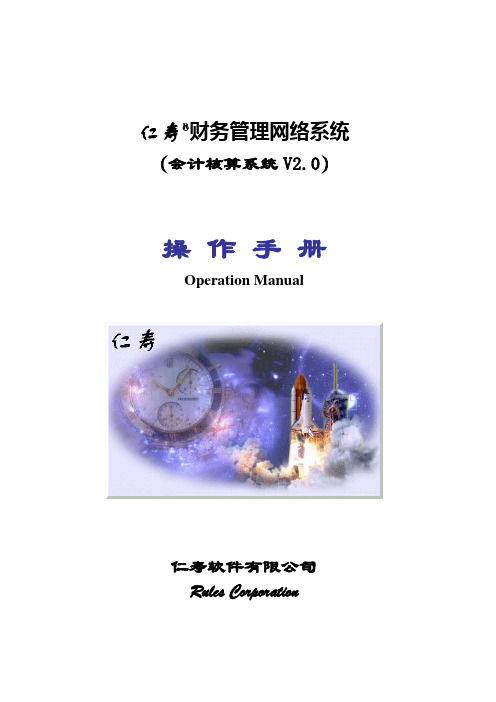
仁寿○R财务管理网络系统(会计核算系统V2.0)操作手册Operation Manual仁寿软件有限公司Rules Corporation仁寿会计核算系统版权声明●仁寿软件有限公司唯一合法拥有本手册著作权,唯一合法拥有本手册的解释和修改权,对任何非法复制和传播行为将依法保留追究法律责任的权力。
●本公司可能会对本系统进行完善或升级,并将及时通过各种方式告知或发布给用户。
由此可能造成本手册与软件系统不同步,敬请谅解。
●本公司不保证本手册完全没有错误,对其中的错误不承担法律责任。
●若发现本手册有任何问题或有建议,请及时与本公司联系,以便改进。
仁寿软件有限公司湖北省武汉市洪山区珞喻路1037号E-Mail:xjw72@ZIP:430074仁寿○R为仁寿软件有限公司注册商标。
仁寿会计核算系统目录第一章系统简介 (1)主要内容 (1)系统特色 (1)与原系统比较 (2)第二章系统安装 (4)系统需求 (4)安装准备 (4)M ICROSOFT SQL S ERVER 2000的安装 (5)本系统安装 (9)进入本系统 (12)导入系统模板 (13)第三章系统升级 (15)第四章系统管理 (16)科目体系设置 (16)设置完毕 (20)系统参数设置 (20)重新初始化 (22)清历史数据 (23)科目清理 (23)重新注册 (23)主控数据库设置 (23)账套管理 (24)账套选择 (26)仁寿软件有限公司第五章用户管理 (27)用户列表 (27)功能对象权限 (27)客户机登录权限 (28)操作日志查看 (29)第六章凭证处理 (30)凭证填制 (30)凭证审核 (38)凭证删除 (39)凭证浏览 (40)凭证总览 (40)凭证痕迹 (41)接口凭证定义 (41)接口DBF维护 (47)现金日记录入 (47)银行日记账录入 (47)现金出纳序时账 (48)银行出纳序时账 (48)第七章账务管理 (49)条件查询 (49)账簿查询 (50)账簿启用表 (55)账簿明细表 (55)科目汇总表 (56)科目辅助科目汇总 (56)发生额及余额查询 (57)辅助科目查询 (58)仁寿会计核算系统现金(银行)日记查询 (58)往来账核销 (59)第八章报表分析 (60)报表管理 (60)显示格式维护 (64)报表打印 (65)报表汇总 (66)报表分析 (67)第九章银行对账 (70)期初未达账 (70)银行对账单 (71)银行账勾对 (72)调节表打印 (73)第十章系统服务 (74)本机选项设置 (74)通用数据查询 (75)数据备份恢复 (76)月份结转 (80)年终结转 (80)第十一章帮助 (83)在线帮助 (83)更改口令 (83)个性设置 (83)计算器 (83)同步器 (83)压缩解压工具 (84)仁寿软件有限公司文件复制 (85)网络广播 (85)定时关机 (85)信息提示 (86)打印纸设置 (86)清临时目录 (86)关于仁寿 (86)第十二章其他 (87)注销与登录 (87)备份报表格式 (87)通用打印设置 (87)第十三章常见问题答疑 (89)仁寿会计核算系统第一章系统简介主要内容仁寿®会计核算系统V2.0(以下均简称本系统)是一套以事业单位会计制度为准则开发的、适用于事业单位运用计算机进行会计电算化的应用软件,其主要功能模块包括:●系统管理:是系统的初始准备设置及系统总控管理模块,包括科目体系设置、系统参数设置、重新初始化、账套管理等主要功能模块。
Office 2010办公应用完美互动手册说明书

书籍信息版 次:1页 数:字 数:印刷时间:2014年01月01日开 本:16开纸 张:胶版纸包 装:平装是否套装:否国际标准书号ISBN:9787302339601编辑推荐实战解析:精选实例,全程图解,一步一图,由浅入深,快速上手。
书盘互动:通过图书、视频演示加上互动练习的教学方式,章节互动、边学边练,使学习更加轻松、容易。
版式精美:版式精美、大方,图解标注清晰、醒目,操作精练、图文对应。
内容翔实:全面讲解Word、Excel和PowerPoint三大Office2010组件的相关知识及综合运用。
内容简介Office 2010是一套家喻户晓的办公软件包,其包括了Word、Excel、PowerPoint、OneNo te、Outlook、Publisher、Access以及InfoPath等软件,其中Word、Excel、PowerPoint是人们在办公领域使用最广泛的子软件。
《完美互动手册:Office 2010办公应用完美互动手册》共分为16章和两个附录,主要内容包括:Office 2010基础入门、Word 2010文档的操作技巧、Word 2010文档的表格操作、Word 2010文档对象插入技巧、Word 2010文档的排版设计、Word 2010文档的审阅及打印技巧、Excel 2010工作表的操作技巧、Excel 2010工作表的格式设置、Excel 2010工作表的编辑、Excel 2010工作表的高级应用、PowerPoint 2010幻灯片的基本操作、PowerPoint 2010幻灯片制作、PowerPoint 2010的高级应用、Outlook 2010的设置和应用、Access 2010的设置和应用、Office 2010组件协同办公、Office 2010快捷键和Excel函数速查表等知识。
《完美互动手册:Office 2010办公应用完美互动手册》内容翔实、案例丰富,全程图解、情景教学。
Microsoft Office Project 操作手册(中文界面)
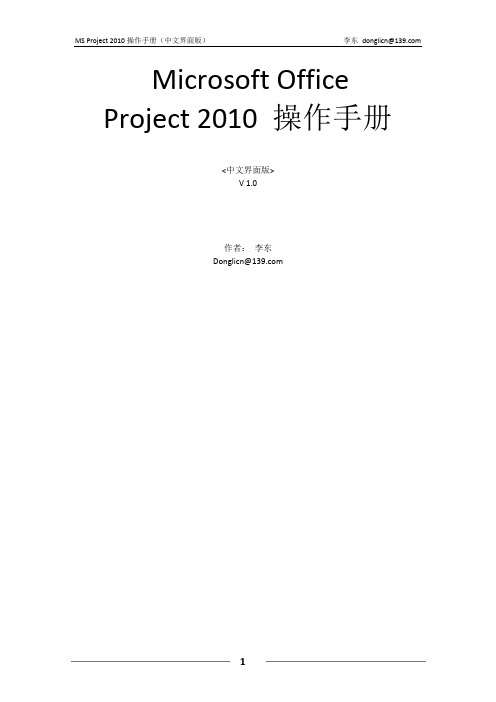
Microsoft Office Project 2010 操作手册<中文界面版>V 1.0作者:李东Donglicn@目录1、启动阶段 (3)1.1、前期准备 (3)1.1.1、新建项目文件 (3)1.1.2、设置项目信息 (4)2、计划阶段 (7)2.1、定义资源 (7)2.2、建立任务 (8)2.2.1、任务列表 (8)2.2.2、插入周期性任务 (11)2.2.3、任务日历 (12)2.2.4、任务工期 (13)2.2.5、建立限制条件 (13)2.2.6、建立依赖关系 (14)2.3、资源分配 (14)3、跟踪阶段 (16)3.1、比较基准 (16)3.2、跟踪完成进度 (17)4、报告与分析 (18)4.1、盈余分析 (18)5、多项目管理 (19)5.1、创建共享资源 (19)5.2、使用共享资源 (19)6、其它 (19)6.1、如何在“跟踪甘特图”中显示其它比较基准 (19)6.2、基准保存技巧 (19)6.3、如何自定义提醒列 (20)6.4、如何进行计划的调整 (21)6.5、查询可以调整的时间 (21)6.6、关于加班 (22)1、启动阶段1.1、前期准备1.1.1、新建项目文件选择文件—新建菜单,选择项目模版,并点击“创建”按钮:打开项目文件,看见任务表格后,设定任务自动排期1.1.2、设置项目信息自定义日历选择“项目”下的“更改工作时间”菜单:点击“新建日历”,输入日历名称设置例外工期,在表格中输入例外工期的名称,一般是修改的事由,比如“加班”/“十一放假”等。
点击“详细信息”按钮可以进行高级设置,选择周一至周五,设定实际的工作时间,设置非工作时间(图中设置10月1日-7日为非工作日)项目信息定义在“项目”中选择“项目信息”,打开项目信息窗口,在这个窗口中有几个重要信息要设置:开始日期、排序方法、项目日历。
2、计划阶段2.1、定义资源在“任务”中点击“甘特图”下拉按钮,选择将视图切换为“资源工作表”资源分三类,分别为“工时”、“材料”、“成本”,前两种类型均可以设置为费率,但是只有“工时”类型有可用数量限制;可以双击打开资源进行详细设置,比如分时费用,核算方式,可用时间等等。
操作手册-范文-模板
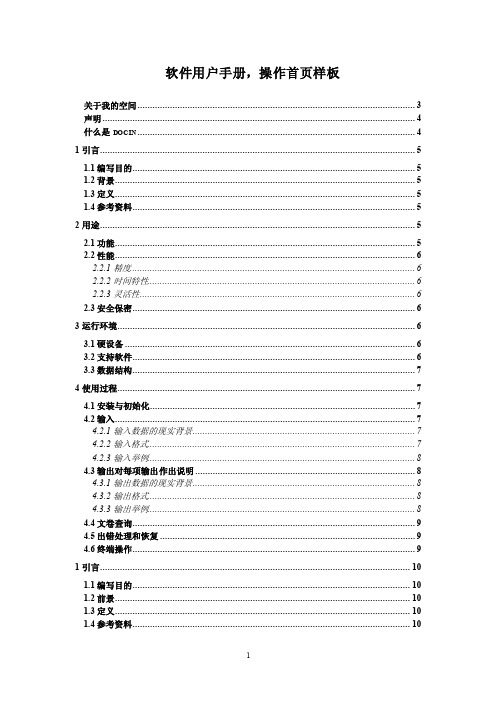
软件用户手册,操作首页样板关于我的空间 (3)声明 (4)什么是DOCIN (4)1引言 (5)1.1编写目的 (5)1.2背景 (5)1.3定义 (5)1.4参考资料 (5)2用途 (5)2.1功能 (5)2.2性能 (6)2.2.1精度 (6)2.2.2时间特性 (6)2.2.3灵活性 (6)2.3安全保密 (6)3运行环境 (6)3.1硬设备 (6)3.2支持软件 (6)3.3数据结构 (7)4使用过程 (7)4.1安装与初始化 (7)4.2输入 (7)4.2.1输入数据的现实背景 (7)4.2.2输入格式 (7)4.2.3输入举例 (8)4.3输出对每项输出作出说明 (8)4.3.1输出数据的现实背景 (8)4.3.2输出格式 (8)4.3.3输出举例 (8)4.4文卷查询 (9)4.5出错处理和恢复 (9)4.6终端操作 (9)1引言 (10)1.1编写目的 (10)1.2前景 (10)1.3定义 (10)1.4参考资料 (10)2软件征述 (10)2.1软件的结构 (10)2.2程序表 (11)2.3文卷表 (11)3安装与初始化 (11)4运行说明 (11)4.1运行表 (11)4.2运行步骤 (11)4.3运行1(标识符)说明 (11)4.3.1运行控制 (11)4.3.2操作信息 (12)4.3.3输入一输出文卷 (12)4.3.4输出文段 (12)4.3.5输出文段的复制 (12)4.3.6恢复过程 (13)4.4运行2(标识符)说明 (13)5非常规过程 (13)6远程操作 (13)关于我的空间我在豆丁的空间:/mydoc-6980014-1.html商业计划书、可行性分析报告等编写;企业文化、集团管控、战略规划等咨询服务;技术开发,数据库设计;招投标文档,项目需求;项目规划等,主要分类如下:◆【休闲-生活百科】:自己平常收集的有意义的,有意思的,或者其他用途的普通文档。
◆【休闲-美女】:休闲一下,给大家写美女看看。
二次元SOV-2010操作指导书

三 阶 文 件
影像测绘仪指导书 版本/次 A/0
4.4 仪器的维护与保养
4.4.1 仪器应放在清洁干燥的室内,避免光学零件表面汗损,金属零件生锈,尘埃杂物落入运动导轨,影响仪器性能。
4.4.2 仪器使用完毕,工作面应随时擦拭干净。
4.4.3 仪器的传动机构及运动导轨、定期上润滑油。
4.4.4 玻璃及油漆表面脏了,可以用中性清洁剂与清水擦拭干净。
绝不能用有机剂擦拭油漆表面,否者会使油漆表面失去光泽。
4.4.5 仪器精密部件,如影像系统、工作台、光学尺以及Z轴传动机构等均需精密调整,所有调节螺丝与坚固螺丝均已固定,不可自行拆卸。
5.7 测量压痕对角线方法如下:
测量压痕对角线时,先转动目镜左边的鼓轮,这时两刻线同时移动,先对准左边压痕的顶点;然后转动右边鼓轮,使另一条线对准右边的顶点。
微软办公软件2010操作指南(适用于IT专业人员)说明书
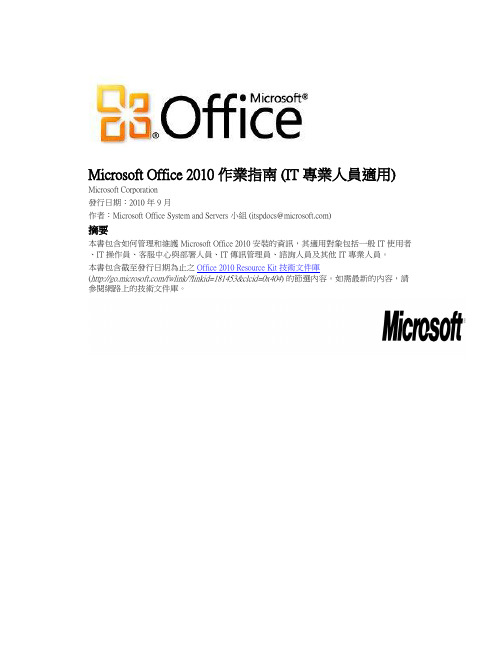
Microsoft Office 2010 作業指南 (IT 專業人員適用) Microsoft Corporation發行日期:2010 年 9 月作者:Microsoft Office System and Servers 小組(**********************)摘要本書包含如何管理和維護 Microsoft Office 2010 安裝的資訊,其適用對象包括一般 IT 使用者、IT 操作員、客服中心與部署人員、IT 傳訊管理員、諮詢人員及其他 IT 專業人員。
本書包含截至發行日期為止之Office 2010 Resource Kit 技術文件庫(/fwlink/?linkid=181453&clcid=0x404) 的節選內容。
如需最新的內容,請參閱網路上的技術文件庫。
本文件係依「現狀」提供。
本文件所陳述的資訊及觀點 (包括 URL 及其他網際網路網站參考) 如有變更,恕不另行通知。
您必須自行承擔使用的風險。
本文所提及之部分範例均為虛構,並僅供說明之用。
其無意指射或影射任何真實的個案。
本文件不提供貴用戶對任何 Microsoft 產品之任何智慧財產的法定權利。
貴用戶可以複製本文件,並將其用為內部參考。
© 2010 Microsoft Corporation. All rights reserved.Microsoft、Access、Active Directory、Backstage、Excel、Groove、Hotmail、InfoPath、Internet Explorer、Outlook、PerformancePoint、PowerPoint、SharePoint、Silverlight、Windows、Windows Live、Windows Mobile、Windows PowerShell、Windows Server 及 Windows Vista 是Microsoft Corporation 在美國及 (或) 其他國家/地區的註冊商標或商標。
微软发布器2010产品指南说明书
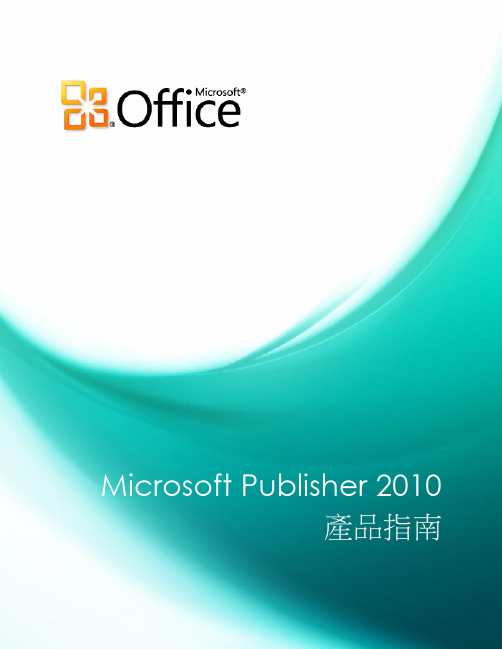
目錄簡介 (1)Publisher 2010:快速瀏覽 (2)建立外觀出色的出版物 (2)節省時間並簡化工作 (3)適時運用正確的工具 (3)讓您更有自信分享出版物 (4)Publisher 2010:深入瞭解 (5)輕鬆存取線上範本增強設計! (5)自訂範本並重複使用自訂內容 (6)建置組塊增強設計! (7)與 Publisher 使用者社群共享全新設計! (8)編輯和使用相片工具全新和增強的設計! (10)物件對齊技術全新設計! (12)精細印刷樣式全新設計! (12)即時預覽全新設計! (14)貼上時即時預覽全新設計! (14)隱藏草稿區全新設計! (16)頁面導覽全新設計! (17)功能區全新設計! (18)Backstage 檢視全新設計! (19)整合的列印體驗全新設計! (20)商業與數位印刷支援增強設計! (21)發佈成 PDF 或 XPS 增強設計! (23)語言工具增強設計! (24)儲存和管理客戶清單 (25)傳送電子報 (25)功能位置 (27)版本比較 (33)常見問題集 (38)需求\揭露 (42)簡介Microsoft® Publisher 2010 提供簡單易用的設計工具,能讓您建立、列印和共享具有專業品質的行銷資料和出版物。
經過更新的使用者介面讓工作更有效率,增強的相片工具讓您獲得更精確的結果,視覺化的指南則能幫助您導覽出版物並查看列印內容。
無論您需要摺頁冊、傳單、目錄或電子報,您都可以用更低的花費和更少的工作量自行製作。
Publisher 2010 讓您輕鬆建立屬於自己的成功宣傳方式。
Publisher 2010:快速瀏覽實現您的創意您不必是專業設計師,就能夠製作出專業的行銷和宣傳資料。
各種預先設計好可自訂的範本,以及簡單好用的設計工具,都可幫助您快速將創意付諸實行,建立視覺效果豐富的出版物。
建立外觀出色的出版物您的內容外觀會大幅影響對象接收資訊的意願。
金万维异速联安装操作说明

金万维异速联 2010 版 用户使用手册二零零九年十二月 COPYRIGHT BY GNWAY产品部文档目 录版用户使用手册................................................................................................................. - 3 金万维异速联 2010 版用户使用手册 第一章 系统简介................................................................................................................................................. - 3 系统简介 1. 1 关于 E-SoonLink 系统 系统..................................................................................................................... - 3 1.2 E-SoonLink 网络拓扑图 网络拓扑图.................................................................................................................... - 4 1.3 E-SoonLink 新功能简介 新功能简介.................................................................................................................... - 5 系统快速安装与使用 速安装与使用............................................................................................................................. - 6 第二章 系统快速安装与使用 2. 1 系统要求 .............................................................................................................................................. - 6 2.2 系统快速安装 ...................................................................................................................................... - 6 2.2.1 服务端的安装............................................................................................................................ - 6 2.2.2 增加用户和发布程序 .............................................................................................................. - 15 2.2.3 客户端的安装及使用 .............................................................................................................. - 17 第三章 系统安装详细配置说明....................................................................................................................... - 20 系统安装详细配置说明 3.1 后台管理程序登陆 ............................................................................................................................ - 20 3.2 用户和组管理 .................................................................................................................................... - 20 3.2.1 用户管理................................................................................................................................... - 20 3.2.2 组管理....................................................................................................................................... - 22 3.3 发布程序管理 .................................................................................................................................... - 24 3.3.1 发布程序.................................................................................................................................. - 24 3.3.2 发布文件.................................................................................................................................. - 26 3.3.3 发布文件夹.............................................................................................................................. - 26 3.3.4 发布链接.................................................................................................................................. - 27 3.3.5 发布桌面................................................................................................................................... - 27 3.4 Web 服务管理 ................................................................................................................................... - 28 3.5 许可证配置管理 ................................................................................................................................ - 29 3.6 安全配置 ............................................................................................................................................ - 30 3.7 在线监控 ............................................................................................................................................ - 31 3.8 集群配置 ............................................................................................................................................ - 33 3.8.1 集群简介................................................................................................................................... - 33 3.8.2 使用方法................................................................................................................................... - 34 3.8.3 支持的负载均衡策略............................................................................................................... - 36 第四章 客户端登陆使用 E-SoonLink ........................................................................................................... - 36 4.1 通过计算机终端访问 ......................................................................................................................... - 36 4.1.1 通过浏览器访问....................................................................................................................... - 36 4.1.2 通过桌面快捷方式访问 ........................................................................................................... - 39 4.2 通过手机等移动终端访问 ................................................................................................................. - 40 第五章 E-SoonLink 端口映射 ....................................................................................................................... - 42 动态域名( 第六章 动态域名(DDNS)解析 ................................................................................................................... - 44 )产品部文档金万维异速联 2010 版用户使用手册第一章 系统简介1. 1 关于 E-SoonLink 系统产品简介 E-SoonLink 将集中管理与远程接入完美地结合起来,使用金万维异速联可以方便、安全及时地接入到 公司内部应用信息系统。
操作手册-demo-2010
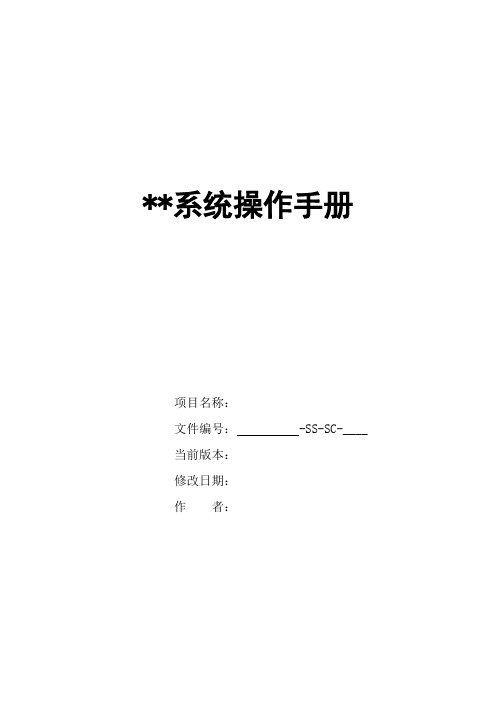
**系统操作手册项目名称:文件编号: -SS-SC-____当前版本:修改日期:作者:文档修订历史变化状态:C--创建,A--增加,M--修改,D--删除文档审批信息目录1引言1.1登录域名:列出本系统登录的域名(注意:不得公布IP)1.2编写目的说明编写这份操作手册的目的,指出预期的读者。
1.3项目背景说明:a)这份操作手册所描述的软件系统的名称;b)该软件项目的任务提出者、开发者、用户。
1.4定义列出本文件中用到的专门术语的定义和外文首字母组词的原词组。
1.5参考资料列出有用的参考资料,如:a)项目的经核准的计划任务书或合同文档;b)本文件中各处引用的文件、资料,包括所要用到的软件开发标准。
列出这些文件资料的标题、文件编号、发表日期和出版单位,说明能够取得这些文件资料的来源。
2软件概述2.1目标简述系统建设的目标2.2功能简述系统的功能2.3性能简述系统的性能数据精确度:a)包括输入、输出及处理数据的精度。
b)时间特性如响应时间、处理时间、数据传输时间等。
c)灵活性在操作方式、运行环境需做某些变更时软件的适应能力。
3运行环境3.1硬件列出软件系统运行时所需的硬件最小配置,如a)计算机型号、主存容量;b)外存储器、媒体、记录格式、设备型号及数量;c)输入、输出设备;d)数据传输设备及数据转换设备的型号及数量。
3.2支持软件如:a)操作系统名称及版本号;b)语言编译系统或汇编系统的名称及版本号;c)数据库管理系统的名称及版本号;d)其他必要的支持软件。
3.3系统安装及初始化详细描述系统的安装步骤及其说明3.4系统卸载详细描述系统的卸载步骤及其说明---- 角色权限及工作流程手册营销管理系统操作手册—角色权限及工作流程手册一、角色分类列表及角色工作内容角色名称、角色级别、角色工作内容二、角色工作流程及对应的功能模块角色工作流程图流程图中每个步骤使用到得功能模块,及功能模块所在页码营销管理系统操作手册—功能模块手册营销管理系统操作手册—图例说明手册****操作手册—故障处理手册逐个故障给出以下的说明:i.故障现象ii.故障原因说明iii.处理流程iv.非常规过程提供应急或非常规操作的必要信息及操作步骤,如出错处理操作、向后备系统切换操作以及维护人员须知的操作和注意事项。
华用相机Demo的使用说明
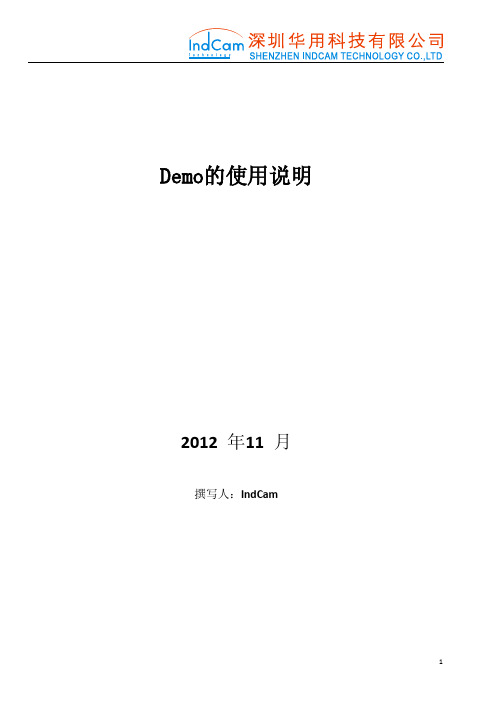
Demo的使用说明2012 年11 月撰写人:IndCam1.打开相机1)Demo的初始运行界面如图1所示。
图1 Demo的初始界面Demo的几个主要功能区域包括:工具栏、网卡列表、图像显示区域以及状态栏,如图2所示。
工具栏包含常用的工具,网卡类表显示在当前主机中检测到的网卡,状态栏主要显示帧率以及当前鼠标的位置。
将鼠标停留在工具栏上的某一工具控件时,可看到当前工具控件的提示信息,在状态栏的最左端,会有该工具控件功能的详细描述。
图2 Demo的界面简介2)选择连接相机的以太网卡,点击工具栏上的“R”,开始运行相机。
如图3所示。
图3 打开相机并运行2.工具控件的使用说明工具栏如图4所示:图4 工具栏各工具控件的主要功能为::打开相机,并开始图像采集。
:停止当前相机的图像采集。
:开始当前相机的图像采集。
;保存一幅图像为bmp文件。
: 打开当前相机的控制属性页。
:打开当前相机的拍照属性页。
:版本信息。
3.保存图片1)保存一幅图像为bmp文件。
点击工具栏上的控件,弹出如图5界面,询问图片的保存路径。
图5 保存图片2)选择图片保存路径,在“另存为”对话框的“文件名”中,输入“图片名称.bmp”,具体如图6所示的“MyCap.bmp”。
注意,一定要添加文件后缀“.bmp”。
写好文件名后,点击“保存”按钮,将把当前显示的图像保存到bmp文件中。
图6 输入图片文件名4.控制属性页4.1 显示控制属性页点击工具栏上的,将显示当前相机的控制属性页,如图7所示。
图7 控制属性页控制属性页包含如下几个区域:视频模式的设置与获取、黑电平控制、增益控制、曝光控制、伽马校正、保存当前相机配置到初始化文件。
1)视频模式的设置与获取。
主要包括图像的分辨率、图像的色彩模式(Color)、图像的镜像方向(Mirror)的设置与获取。
在相机控制属性对话框中的位置分布,如图8所示。
图8视频模式的设置与获取2)黑电平控制模块黑电平控制模块,主要包括自动模式(Auto)、手动模式(Manual)、禁止(Disable),三种模式控制。
- 1、下载文档前请自行甄别文档内容的完整性,平台不提供额外的编辑、内容补充、找答案等附加服务。
- 2、"仅部分预览"的文档,不可在线预览部分如存在完整性等问题,可反馈申请退款(可完整预览的文档不适用该条件!)。
- 3、如文档侵犯您的权益,请联系客服反馈,我们会尽快为您处理(人工客服工作时间:9:00-18:30)。
**系统操作手册
项目名称:
文件编号: -SS-SC-____
当前版本:
修改日期:
作者:
文档修订历史
变化状态:C--创建,A--增加,M--修改,D--删除
文档审批信息
目录
1引言
1.1登录域名:
列出本系统登录的域名(注意:不得公布IP)
1.2编写目的
说明编写这份操作手册的目的,指出预期的读者。
1.3项目背景
说明:
a)这份操作手册所描述的软件系统的名称;
b)该软件项目的任务提出者、开发者、用户。
1.4定义
列出本文件中用到的专门术语的定义和外文首字母组词的原词组。
1.5参考资料
列出有用的参考资料,如:
a)项目的经核准的计划任务书或合同文档;
b)本文件中各处引用的文件、资料,包括所要用到的软件开发标准。
列
出这些文件资料的标题、文件编号、发表日期和出版单位,说明能够
取得这些文件资料的来源。
2软件概述
2.1目标
简述系统建设的目标
2.2功能
简述系统的功能
2.3性能
简述系统的性能数据精确度:
a)包括输入、输出及处理数据的精度。
b)时间特性如响应时间、处理时间、数据传输时间等。
c)灵活性在操作方式、运行环境需做某些变更时软件的适应能力。
3运行环境
3.1硬件
列出软件系统运行时所需的硬件最小配置,如
a)计算机型号、主存容量;
b)外存储器、媒体、记录格式、设备型号及数量;
c)输入、输出设备;
d)数据传输设备及数据转换设备的型号及数量。
3.2支持软件
如:
a)操作系统名称及版本号;
b)语言编译系统或汇编系统的名称及版本号;
c)数据库管理系统的名称及版本号;
d)其他必要的支持软件。
3.3系统安装及初始化
详细描述系统的安装步骤及其说明3.4系统卸载
详细描述系统的卸载步骤及其说明
---- 角色权限及工作流程手册营销管理系统操作手册—角色权限及工作流程手册
一、角色分类列表及角色工作内容
角色名称、角色级别、角色工作内容
二、角色工作流程及对应的功能模块
角色工作流程图
流程图中每个步骤使用到得功能模块,及功能模块所在页码
营销管理系统操作手册—功能模块手册
营销管理系统操作手册—图例说明手册
****操作手册—故障处理手册
逐个故障给出以下的说明:
i.故障现象
ii.故障原因说明
iii.处理流程
iv.非常规过程
提供应急或非常规操作的必要信息及操作步骤,如出错处理操作、向后备系统切换操作以及维护人员须知的操作和注意事项。
